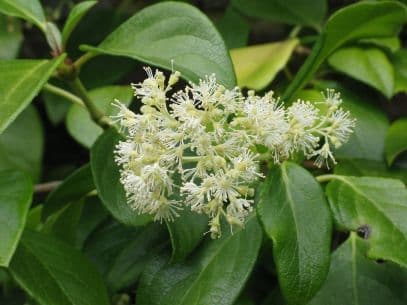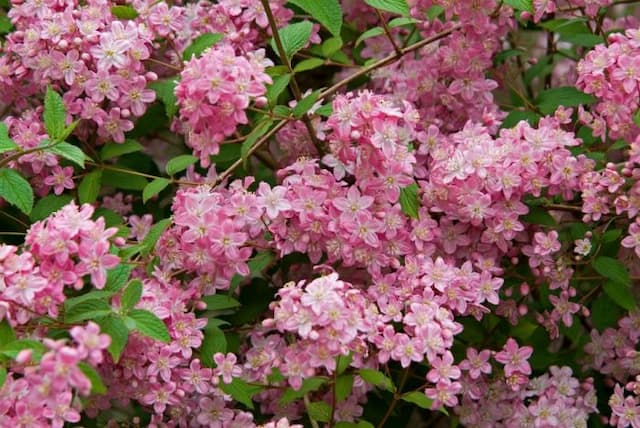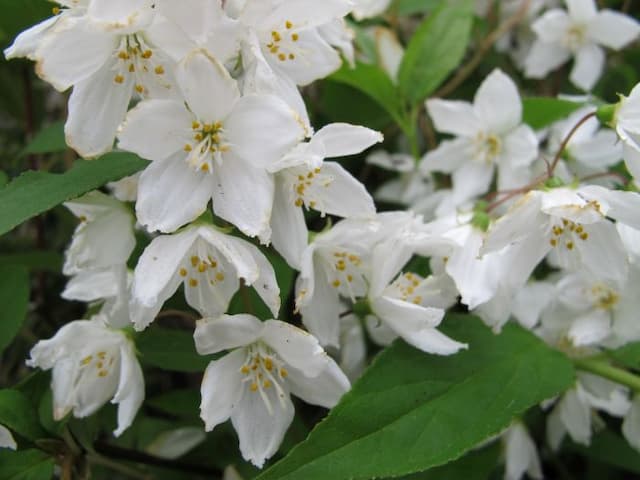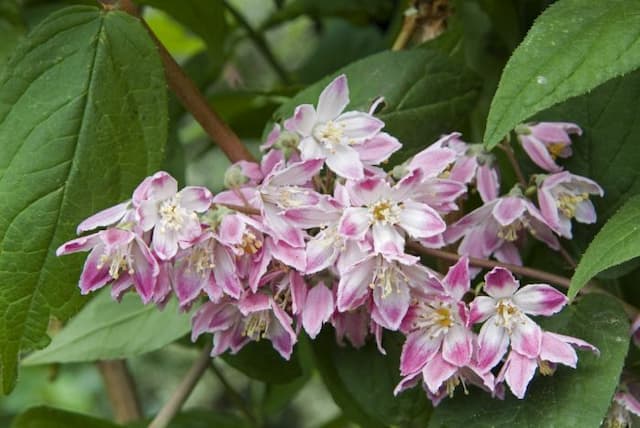Hydrangea Hydrangea macrophylla 'Dark Angel' (Black Diamonds Series) (L)

ABOUT
The Hydrangea 'Dark Angel' from the Black Diamonds Series is a striking ornamental plant known for its vibrant blooms and lush foliage. Its flowers are a standout feature, presenting in a deep, rich pink or purple color, depending on the soil's acidity. The blooms are large, rounded clusters that create a dramatic contrast against the dark green leaves. These leaves are another characteristic aspect of the 'Dark Angel', as they exhibit a unique reddish-black hue that can appear almost metallic or glossy in the right light, adding to the plant's overall dramatic and luxurious appearance. The combined effect of the dark foliage and vivid blooms makes this hydrangea a captivating and elegant addition to any garden that draws attention throughout its blooming season.
About this plant
 Names
NamesFamily
Hydrangeaceae
Synonyms
Dark Angel Hydrangea, Black Diamonds Dark Angel Hydrangea
Common names
Hydrangea macrophylla 'Dark Angel' (Black Diamonds Series) (L).
 Toxicity
ToxicityTo humans
Hydrangeas can be mildly toxic to humans if ingested. The plant contains cyanogenic glycosides, which can release cyanide when chewed or digested. Symptoms of poisoning could include stomach upset, nausea, vomiting, and diarrhea. In severe cases, it could lead to more serious symptoms like difficulty breathing, lethargy, and even seizures. Although serious cases are rare, it is advised to avoid ingesting any part of a hydrangea, including the Hydrangea macrophylla 'Dark Angel'.
To pets
Hydrangeas, including the Hydrangea macrophylla 'Dark Angel', are toxic to pets such as dogs and cats. The toxicity is due to the presence of cyanogenic glycosides found in the plant's leaves, flowers, and buds. If a pet ingests any part of the hydrangea, symptoms of poisoning may include drooling, vomiting, diarrhea, and lethargy. In severe cases, ingestion could lead to cyanide poisoning and could be fatal. If you suspect your pet has eaten any part of a hydrangea, it is important to contact a veterinarian immediately.
 Characteristics
CharacteristicsLife cycle
Perennials
Foliage type
Deciduous
Color of leaves
Green
Flower color
Varies
Height
4 feet (1.2 meters)
Spread
4 feet (1.2 meters)
Plant type
Shrub
Hardiness zones
6
Native area
Asia
Benefits
 General Benefits
General Benefits- Striking Aesthetic Appeal: This hydrangea features deep purple to blue or pink flowers, adding a dramatic touch to gardens and landscapes.
- Versatility in Landscaping: It can be used in various design scenarios, such as specimen planting, borders, or container gardening.
- Seasonal Interest: Provides vibrant color from late spring to early fall, enhancing the visual appeal of gardens through multiple seasons.
- Attracts Pollinators: The flowers attract bees and butterflies, supporting local ecosystems and biodiversity.
- Shade Tolerance: The 'Dark Angel' hydrangea can tolerate partial shade, offering a flowering solution for less sunny garden spots.
- Durable Blooms: The plant boasts robust flower heads that can withstand summer rains and do not flop as readily as some other varieties.
- Easy Pruning: It can be pruned after flowering, requiring less precision than some other species which must be pruned at specific times to avoid cutting off next year's buds.
- Soil pH Responsiveness: The flower color changes (blue in acidic soils and pink in alkaline), which can be both an attractive novelty and a natural pH indicator for gardeners.
 Medical Properties
Medical PropertiesThis plant is not used for medical purposes.
 Air-purifying Qualities
Air-purifying QualitiesThis plant is not specifically known for air purifying qualities.
 Other Uses
Other Uses- Photography Prop: The vibrant colors of Hydrangea can serve as a stunning backdrop for portrait photography, providing natural contrast and depth to photos.
- Craft Material: Dried Hydrangea flowers can be used in crafting, such as for making flower arrangements, wreaths, or potpourri.
- Color Indicator: Hydrangea's flowers can change color depending on the pH of the soil, which can be used in educational settings to demonstrate soil chemistry.
- Fabric Dye: The pigments in Hydrangea flowers can be used to create a natural dye for fabrics, offering shades of blue, pink, or purple.
- Wedding Decor: Because of their large, eye-catching blooms, Hydrangeas are often used in wedding bouquets and as venue decorations.
- Culinary Garnish: Although not common, the vibrant petals (if pesticide-free) could potentially be used as an elegant garnish for special dishes.
- Bookmark Creation: Pressed Hydrangea flowers can be used in creating beautiful and unique bookmarks.
- Festival Decor: Hydrangeas can be featured in floral displays during festivals, particularly in regions where they are grown locally and abundantly.
- Teaching Tool: Their unique ability to change color with soil pH can be used to educate students about acid-base reactions and hydrangea care.
- Art Supplies: Petals and leaves from the Hydrangea can be used in art projects such as making natural collages or botanical prints.
Interesting Facts
 Feng Shui
Feng ShuiThe Hydrangea is not used in Feng Shui practice.
 Zodiac Sign Compitability
Zodiac Sign CompitabilityThe Hydrangea is not used in astrology practice.
 Plant Symbolism
Plant Symbolism- Heartfelt Emotions: Hydrangeas, in general, are known to symbolize heartfelt and genuine emotions. The lavish, rounded shape of the blooms represents abundance and generosity of feeling.
- Gratitude: The hydrangea, especially in hues of pink, can represent gratitude and heartfelt thanks. Offering a hydrangea can be a way of saying "Thank you for understanding" and for deep appreciation.
- Apologies: Sometimes hydrangeas are used to express an apology or a desire for reconciliation, possibly because they carry a message of "Let's try again," hinting at new beginnings and renewing relationships.
- Vanity or Boastfulness: Some traditions point to another, less favorable symbolism of hydrangeas: vanity or boastfulness, possibly due to their extravagant clusters of flowers and their ability to overshadow other garden plants.
- Enduring Grace and Beauty: The 'Dark Angel' variety, with its deep colors and hardy nature, can be reflective of a more enduring and steadfast grace, as well as beauty that persists in various conditions.
- Abundance: Because the hydrangea plant often produces a large number of flowers, it can be symbolic of abundance and prosperity.
- Perseverance: The ability of hydrangeas to bloom in varying soil pH levels, thus changing color, can symbolize perseverance and the ability to adapt to circumstances.
 Water
WaterBigleaf hydrangeas, including the Dark Angel Hydrangea, prefer consistently moist soil, so regular watering is important, particularly during dry spells in summer. They should be watered thoroughly, receiving about 1 gallon of water per week during the growing season. Avoid overhead watering to prevent leaf spot diseases and instead focus the water at the base of the plant. During hot or windy weather, you might need to water more frequently to keep the soil from drying out. Reduce watering during the winter months when the plant is dormant.
 Light
LightDark Angel Hydrangeas thrive in partial shade with some morning sun and afternoon shade to protect their blooms and leaves from intense heat and sunlight. An ideal spot would offer dappled sunlight or light shade throughout the day. Too much sun can cause leaf scorch, while too little can reduce flowering.
 Temperature
TemperatureBigleaf hydrangeas like Dark Angel Hydrangea prefer a temperate climate and can usually handle temperatures as low as 20°F without significant damage. They thrive best in temperatures ranging from 65°F to 75°F. Extended periods of extreme cold below 20°F may damage the plant, and it's important to provide adequate winter protection in colder regions.
 Pruning
PruningPrune the Dark Angel Hydrangea after blooming to remove spent flower heads and to shape the plant. This variety blooms on old wood, so avoid heavy pruning in late winter or early spring which can remove flower buds. It's typically enough to cut back just above the first set of large buds to encourage both growth and flowering for the following season.
 Cleaning
CleaningAs needed
 Soil
SoilHydrangeas prefer rich, well-draining soil with a pH that can affect bloom color—acidic (pH below 6) for blue flowers, neutral to alkaline (pH 7 to above) for pink. A mix of peat, compost, and perlite or vermiculite is ideal.
 Repotting
RepottingBigleaf hydrangeas should be repotted every 2-3 years or when the root system outgrows the pot. Choose a slightly larger container to allow for growth.
 Humidity & Misting
Humidity & MistingHydrangeas thrive in environments with moderate to high humidity levels, ideally between 50-70%. They can tolerate lower humidity, but prefer consistently moist air.
 Suitable locations
Suitable locationsIndoor
Position for bright, indirect light and keep soil moist.
Outdoor
Plant in partial shade, water regularly, and shelter from harsh sun.
Hardiness zone
6-9 USDA
 Life cycle
Life cycleThe life of a Hydrangea macrophylla 'Dark Angel,' commonly known as Bigleaf Hydrangea or French Hydrangea, begins with germination, where the seed sprouts in moist, well-draining soil during the springtime after a period of cold stratification. As a perennial, the seedling grows into a young plant with characteristic large, serrated, dark green leaves and strong stems, usually in partial shade. Throughout the spring and summer, it enters a vegetative growth stage, building up reserves and increasing in size. By early to mid-summer, the plant begins its reproductive stage, displaying its striking large flower heads composed of tiny fertile flowers surrounded by showier sterile flowers, with colors ranging from deep blue to pink depending on soil pH. After blooming, if the flowers are pollinated, the plant may produce seeds, which disperse naturally or can be collected before the plant enters a period of dormancy in the fall and winter months. The hydrangea remains dormant through the cold season, drawing on its stored resources, until favorable growth conditions return and it can resume its growth cycle in the spring.
 Propogation
PropogationPropogation time
Spring-Early Summer
Propogation: The most popular method of propagating Hydrangea macrophylla 'Dark Angel', commonly known as Bigleaf Hydrangea, is through softwood cuttings taken in late spring or early summer. To take a cutting, choose a healthy, non-flowering stem with at least three pairs of leaves. Cut the stem just below a pair of leaves using a sharp, clean pair of pruners, making the cutting about 4-6 inches long (approximately 10-15 cm). Remove the lower leaves, leaving only the top pair in place, and dip the cut end into rooting hormone powder. Insert the cutting into a pot filled with moistened soil mix, making sure at least one pair of leaf nodes is beneath the soil surface. Cover the pot with a plastic bag to create a humid environment and place it in bright, indirect light. Keep the soil consistently moist, and in a few weeks, the cutting should develop roots and can be transplanted to a larger pot or garden location.






![Rose deutzia [Yuki Cherry Blossom]](/_next/image?url=https%3A%2F%2Fplants-admin.emdemapps.com%2Fimages%2Fplants%2F%2Fimages%2F604b6510a383a.png&w=640&q=75)

![Hydrangea [Hot Chocolate]](/_next/image?url=https%3A%2F%2Fplants-admin.emdemapps.com%2Fimages%2Fplants%2F%2Fimages%2F604b5a066e3bd.png&w=640&q=75)
![Hydrangea [Blackberry Pie]](/_next/image?url=https%3A%2F%2Fplants-admin.emdemapps.com%2Fimages%2Fplants%2F%2Fimages%2F604b56e2abc1d.png&w=640&q=75)